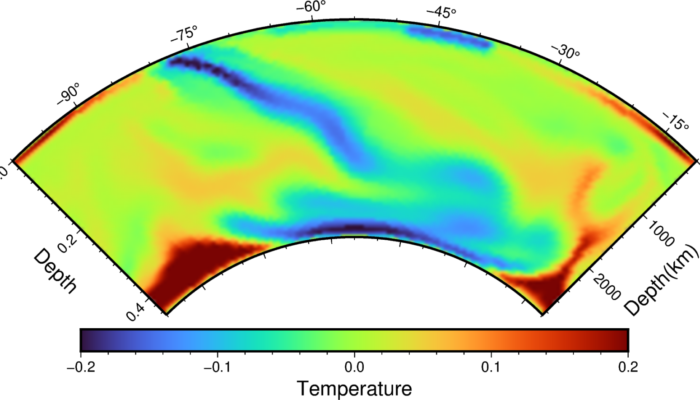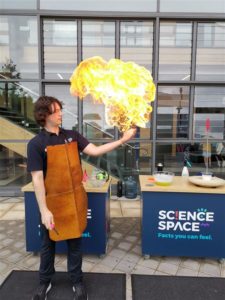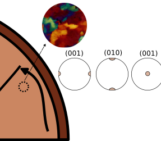
The study of the mantle aids in our understanding of the Earth’s tectonic evolution. In this week’s news and views, honours student Mr. Robert Marks shares his thoughts. Mr. Marks received his Bachelors (Hons) degree from the University of Wollongong under the supervision of Dr Nicolas Flament.
The Earth’s mantle is filled with subducted slabs, which are remnants of tectonic plates that have sunk down into the mantle after colliding with other tectonic plates at the surface. Understanding how these subducted slabs sink is vital to painting a picture of how our Earth has evolved because these slabs drive both mantle convection and plate tectonic motion. I’ve just completed my honours thesis at the University of Wollongong under the supervision of Dr Nicolas Flament, and it was these subducted slabs that were the focus of my research.
It’s quite daunting to set out on an honours year, a nine month long project, unlike any other undergraduate work I’d done, but it has been by far the greatest educational opportunity ever afforded to me. Not only do I feel that I’ve learnt more this year than in any year previous, but I also got the chance to contribute to academic knowledge in a way that isn’t otherwise available to undergraduate students; Instead of finding an already known answer for some assignment so I could get a good mark, I finally got to tackle a question without a known answer, and now I get to share my knowledge with the academic community and help push the boundaries of what we know.
My approach to understanding how subducted slabs move was to dive into forward numerical models of mantle convection, which predict how the mantle evolves over vast periods of time. I find forward models like these fascinating. Many geological processes, like mantle convection, occur over timescales far greater than any human lifespan, so they can feel somewhat inaccessible. Looking at these models has given me the chance to explore these immense timescales, which has been super exciting. There are quite a few mantle convection models that exist, so before I looked too in-depth at how the slabs move, I compared a few models to find which was best. The models I looked at were presented in Muller et al. (2022) and all used a reconstruction of plate tectonic motion at the surface to provide information on both where subduction is occurring through time and how tectonic plates are moving at the surface. The only difference between the three models was the plate tectonic reconstruction used.
To figure out which model to pick, I compared each one back to a dataset independent of the models. For this, I compared seismic tomographic images of the mantle, which use earthquake waves to develop a picture of Earth’s interior, to what the present-day mantle looks like in each model; By comparing how well the subducted slabs predicted by the model match the images of the mantle, we can pick which model predicts the present-day mantle the best. While I didn’t get the chance to explore seismic tomography too much, it was still quite an interesting look into other methods used to study the mantle. Getting that exposure to diverse avenues of research has been really valuable, especially as I search now for PhD opportunities that interest me.
This honours work has also helped me develop skills that I expect will be invaluable throughout my career. I predominantly used the Python programming language and the Generic Mapping Tools 6 (GMT) to assess the models and the sinking behaviours of the slabs. This was a fun challenge, because before this project my programming experience was limited, and my GMT experience was non-existent. It wasn’t all smooth sailing right from the word go, there were some teething issues and hurdles to overcome, but that’s all part of the experience. Now that I’ve become a bit more familiar with these tools, I’m excited to see what more I can accomplish with them, it feels as though I’ve just scratched the surface of their potential.
I ended up finding that the plate tectonic reconstruction at the surface has an enormous influence on the subducted slabs, not just on where they subduct, but also on how they sink through the mantle. There were two particularly interesting results; I found that the rate slabs sink at is controlled by the rate at which plates converge at the surface, and that slabs in all models tend to move sideways quite a bit, rather than straight down.
There are plenty more results where those came from, you can cover a lot of ground when you’re focussing on one question full-time for months on end, but if you want to see them, you’ll have to wait for the publication (in the meantime, the scripts I developed are freely available online here). The sheer volume of results was, at times, intimidating. Figuring out how it all fit together was quite the puzzle, but when everything started to come together it was incredibly rewarding.
This has been, by far, the largest undertaking of my life, and I am so glad I chose to do it. I’ve also been lucky enough to present my honours work at the Virtual GSA Earth Science Student Symposium, where I was awarded the People’s Choice Award. I’ve had the chance to dip my toe into the world of academia, and I can’t wait to dive right in.
References:
Müller, R.D., Cannon, J., Tetley, M., Williams, S.E., Cao, X., Flament, N., Bodur, Ö.F., Zahirovic, S. and Merdith, A., 2022. A tectonic-rules based mantle reference frame since 1 billion years ago–implications for supercontinent cycles and plate-mantle system evolution. Solid Earth Discussions, pp.1-42.





